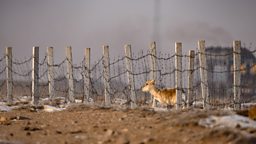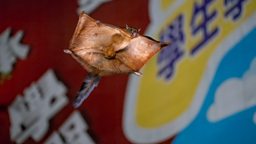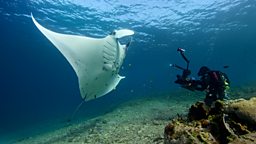A tale of two worlds in the Dhofar Mountains
By Joseph Russell, Assistant Producer

It’s not often that wildlife crews get to revisit filming locations. We normally go to great lengths to avoid doing this; a lot of research goes into planning shoots to be just the right length of time to capture what we need. But for our “Above the Clouds” episode, one sequence proved the exception to this rule, and filming it would entirely hinge on a schedule that would have us return months apart to one small corner of the Middle East…
...a seasonal transformation of epic proportions.
Every year, the Dhofar Mountains on the southern coast of Oman play host to a dramatic monsoon known locally as the Khareef, with its arrival triggering a seasonal transformation of epic proportions. Moist air is blown in from the sea, and is pushed up the mountain slopes, forming a dense fog which is held in place by the peaks. In these humid conditions, water droplets condense on the parched plants and soon the normally barren landscape explodes into colour. Greenery takes over the mountains, rivers start to flow through dry valleys, and animal life emerges in countless forms.
Since the change happens over several weeks, we needed to think a little outside the box on how best to capture the story. To film the entire event from start to finish, we elected to divide and conquer. One team would set up timelapse cameras in the field, to be left capturing the scene day by day. The gear would need to be weatherproof, camouflaged (to avoid unwanted interference from both humans and animals), and self-sufficient. Luckily, some rooting around in the ������̳’s kit store led us to some very futuristic-looking camera housings. They were tough, sealed against the elements and could be hooked up to solar panels to run indefinitely.

The second team was tasked with capturing shots from before and after the monsoon at a particular location; we'd be using some clever editing later to mix between the footage they filmed. The aim was to clearly show the transition from a brown to a green world, as the Khareef worked its magic.
Armed with our bright ideas, we travelled to Oman.
We were particularly excited about this technique, as we hoped to use moving shots to create dynamic transitions. The trickiest part of this approach was the need to get cameras in exactly the same place, months apart - not just roughly right, quite literally identical to the nearest millimetre. To do this, two bits of kit would be invaluable; a drone capable of repeating GPS-controlled flight paths with pinpoint accuracy, and a custom scaffolding setup built to get our camera to slide in precise, recordable and repeatable ways.
Armed with our bright ideas, we travelled to Oman. We arrived in May - the hottest month of the year - to capture our dry ‘pre-monsoon’ shots, and our two teams set out to start the challenge. Both were looking for vistas that would show the biggest change a few months down the line, and it soon became clear there were telltale signs everywhere you looked. Coming across bizarre crystalline formations etched onto some cliffs for example, we realised that waterfall torrents had once gushed here, and in a few weeks they would hopefully return.

Our remote time lapse team was led by Cinematographer Steven McGee-Callender. Armed with a large collection of remote cameras, he spent days navigating snake-infested valleys, constructing pyramidal structures of scaffolding to protect the filming gear. Once set, they would be left firing for weeks on end, hopefully watching on as the Khareef swept in.
...the harsh reality of the boom and bust the Khareef imposes on all life here.
The filming team set out to find similar locations for drone shots and slider moves, but soon realised how tricky the task was. Setting up the elaborate slider meant there were a lot of moving parts to consider – marking the exact position of the tripod legs was easy (a tent peg in the ground would do it), but keeping a record of the height of the slider, the angle of the lens, and the move our camera made wasn’t so straightforward. All these variables were written in a notebook filled with scribbled measurements and reminders.
During our dry season filming, one location captured our attention more than all others. Our local fixer Jas Jaffer had wooed us with tales of a picturesque and remote valley carved from the mountainside, which felt the effects of the Khareef particularly strongly. On arrival, we started hiking up its baked riverbed, but a hundred metres or so into our journey the crew was almost simultaneously hit by what I can genuinely describe as the worst smell I’ve ever had the misfortune to experience. Personal hygiene can sometimes take a hit on remote shoots, but after a quick round of pointing fingers, we realised the smell wasn’t coming from any of us. We combed the area and quickly found the source - a depression in the riverbed a few metres wide, filled with rotting fish carcasses and baked in the sun. While rivers ran full of life during the Khareef, outside these plentiful months the moisture soon evaporates - the harsh reality of the boom and bust the Khareef imposes on all life here.

With all ‘pre-Khareef’ shots captured, and the remote cameras deployed, all we could do was keep our fingers crossed for an on-schedule monsoon, and head home for a few months.
The explosion of life had exceeded our expectations...
On our return, we were absolutely blown away. The colour was incredible, and the life on display made the landscape often feel unrecognisable. Camels were bathing in lakes, chameleons had emerged to hunt insects in the trees now adorned with leaves, kingfishers hunted along the riverbanks and vibrant flowers peppered the newly-grown grasslands.
The explosion of life had exceeded our expectations, and that created some problems. Our first task was to find our remote cameras, and assess how many had fired successfully in their three months of solitude. To our surprise, one of the setups had been so overgrown with vegetation, that the solar panel was now almost completely obscured under a canopy of leaves. One camera had been placed on a ledge which was now separated from the dirt road by a wide river - waders were needed to retrieve it. Remote camera work like this can be very hit or miss, so while leaks, battery issues and glitches hit several setups, a few managed to record right through the Khareef - to our team’s delight.

The camera crew faced similar challenges. One of our slider positions had been so overgrown it took us over an hour to locate the tent pegs.
...we managed to build up an inventory of shots from all corners of the Dhofar mountains...
Other sites were barely accessible through the tangle of vines and bushes that had erupted on what was once barren slopes. Matching up our ‘before’ and ‘after’ shots proved incredibly painful too - new plants had grown where none existed, large leaves now blocked shots, and branches weighed down with tangled vines now occupied entirely different positions in three-dimensional space.
Through a combination of blood, sweat and muttered profanities we managed to build up an inventory of shots from all corners of the Dhofar mountains, revealing the dramatic change of the Khareef like never before. Making two trips to the same location required a lot of time and resources, but the results made it all worth it.




































